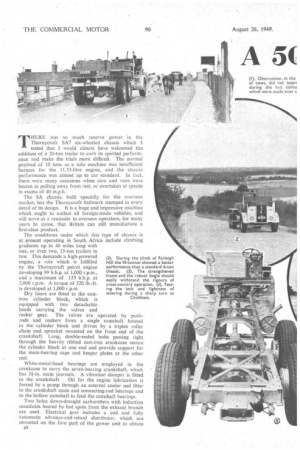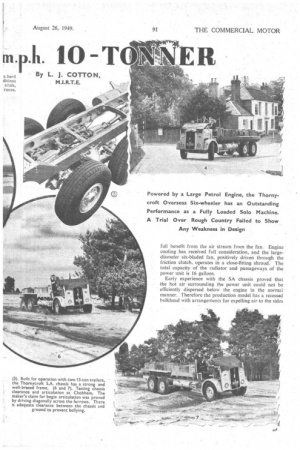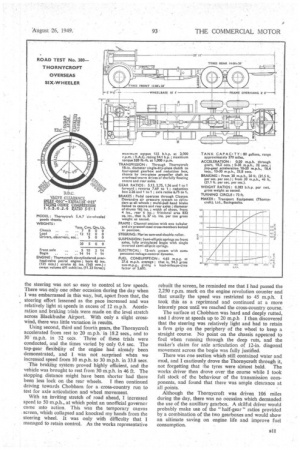A5( .h. 10-T ER
Page 42

Page 43

Page 44

Page 45

If you've noticed an error in this article please click here to report it so we can fix it.
By L. J. COTTON,
M.I.R.T.E.
THERE was so much reserve power in the Thornycroft SA7 six-wheeled chassis which I tested that I would almost have welcomed the addition of a 20-ton trailer to curb its spirited performance and make the trials more difficult. The normal payload of 10 tons as a solo machine was insufficient harness for the 11.33-litre engine, and the chassis performance was almost up to car standard. In fact, there were many occasions when cars and vans were beaten in pulling away from rest, or overtaken at speeds in excess of 40 m.p.h.
The SA chassis, built specially for the overseas market, has the Thornycroft hallmark stamped in every detail of its design. It is a huge and impressive machine which ought to outlast all foreign-made vehicles, and will serve as a reminder to overseas operators, for many years to come, that Britain can still manufacture a first-class product.
The conditions under which this type of chassis is at present operating in South Africa include climbing
gradients up to 40 miles long with one, or even two, 15-ton trailers in
tow. This demands a high-powered engine, a role which is fulfilled by the Thornycroft petrol engine developing 99 b.h.p. at 1,000 r.p.m., and a maximum of 155 b.h.p. at 2,000 r.p.m. A torque of 520 lb.-ft. is developed at 1,000 r.p.m.
Dry liners are fitted to the castiron cylinder block, which is equipped with two detachable . heads carrying the valves and rocker gear. The valves are operated by pushrods and rockers from a single camshaft housed in the cylinder block and driven by a triplex roller chain and sprocket mounted on the front end of the crankshaft. Long, double-ended bolts passing right through the heavily ribbed cast-iron crankcase secure the cylinder block at one end and provide support for the main-bearing caps and keeper plates at the other end.
White-metal-lined bearings are employed in the crankcase to carry the seven-bearing crankshaft, which has 31-in, main jouinals. A vibration damper is fitted to the crankshaft. Oil for the engine lubrication is forced by a pump through an external cooler and filter to the crankshaft main and connecting-rod bearings and to the hollow camshaft to feed the camshaft bearings.
Two Solex down-draught carburetters with induction manifolds heated by hot spots from the exhaust branch are used. Electrical gear includes a coil and fully automatic advance-and-retard distributor, which are mounted on the fore part of the power unit to obtain
(2). During the climb of Farleigh Hill the 10-tonner showed a better performance than a standard 6-ton chassis. (3). The strengthened frame and the robust bogie should easily withstand the rigours of cross-country operation. (4). Testing the lock and lightness of steering during a sharp turn at
Chobham.
full benefit from the air stream from the fan. Engine cooling has received full consideration, and the largediameter six-bladed fan, positively driven through the friction clutch, operates in a close-fitting shroud. The total capacity of the radiator and passageways of the power unit is 16 gallons.
Early experience with the SA chassis proved that the hot air surrounding the power unit could not be efficiently dispersed below the engine in the normal manner. Therefore the production model has a recessed bulkhead with arrangements for expelling air to the sides of the chassis. The volume of air forced past the engine may be judged by the power absorbed by the Ian, which is approximately 8 h.p. at 2,000 r.p.m.
The massive proportions of the cast-iron main and auxiliary gearbox casing indicate that the shafts, gears and gearings are of adequate size for the engine and the demands of heavy service Both control levers are mounted remotely, the main-gearbox lever being carried on an outrigger bracket attached to the crankcase casting.
Hardy Spicer universally jointed shafts are used for the propeller shafts and the intermediate shaft between the overhead worm drives of the centre and rear axles. These Iv/ axles are linked by a single spring at each side and have a buffer arrangement on each spring carrier to prevent excessive side float of the axles. This, although a small detail, is important, especially in vehicles working on an arduous route where excessive axle float would Cause heavy tyre scuffing and rapid wear of the spring and carrier.
High-lift Brake Cams
A Clayton Dewandre braking system is used, the reciprocating compressor being attached to, and driven mechanically by, the engine. Air from the compressor is passed through an unloader valve to two reservoirs. The air cylinders, one to each wheel, are carried by brackets attached to the axles. They operate, through rods and levers, on cams which are designed for a high lift, ensuring an adequate margin of safety for prolonged use when descending the long gradients encountered in such territory as South Africa.
The test chassis was loaded and ready for the road when I arrived at Basingstoke, and after a preliminary glance over it to irake notes of its specification, I prepared for the consumption trial. Both tanks were filled with petrol until they overflowed and the engine started in readiness for a course planned over the A30 road towards Salisbury.
The engine was nursed for the first half-mile, after which it was sufficiently warm for full throttle. Shortly after leaving Basingstoke, the Thornycroft was pulling tip a long gradient at 25 m.p.h. in third gear, and the water temperature between the cylinder head and thermostat settled to a steady 150 degrees F. Atmospheric temperature remained fairly constant at 68 degrees F.
Correcting Speedometer Readings As the tyres were well worn, I checked the speedometer for accuracy on the first level stretch and found it to be 8 per cent. fast. After this, corrections were made,for all speeds and distances recorded during the day's trials.
When branching away from the Winchester road at Micheldever station a herd of cattle caused a two-minute delay. Stockbridge was free from traffic and the hill out of the town was tackled in fine style. It appeared likely that the gradient could be climbed in third gear, but a second hindrance, in the form of a large herd of cows, reduced the speed to walking pace and necessitated the engagement of bottom gear for just over three minutes.
When clear of this obstruction, the pace was increased and the Thornycroft cruised at a steady 40-45 m.p.h. The main-road gradients were climbed with little drop in road speed, because there was a reasonable reserve -of power when the accelerator was fully depressed.
A sharp turn for the return fork of the route was made at Lobscombe Corner, and the works driver demonstrated the smoothness and flexibility of the engine by engaging direct drive and opening the throttle
at 500 r.p.m. engine speed. The chassis increased speed at an even rate, and .there was not the slightest trace of flat spot in the carbuiation. I noted a slight " pinking " between 15 m.p.h. and 20 m.p.h., which proved that the ignition was somewhere near its correct setting.
After a brief delay in Andover, the course was continued towards Whitchurch, on the B3400 road. This was relatively free from slow-moving vehicles and a steady 35-40 m.p.h. was maintained with safety. The water before the thermostat remained at 148 degrees F. as a normal running temperature, and the highest reading recorded during the day was 158 degrees F.
Returning to Basingstoke at the end of the trials, the speedometer showed that a distance of exactly 60 miles had been covered. Allowing for the inaccuracy, the true distance of 55.2 miles was covered in a few seconds under two hours, which corresponds to an average speed of 27.6 m.p.h. No allowances were made for the delays during the course. The tanks were replenished to the original level, and precisely 11i gallons of petrol were required to bring them to overflow point. This gives a fuel return of 4.65 m.p.g. or, developed into hauliers' language, a load-mileage-time factor of 2,600.
Temperatures were taken on the completion of the. test, and readings of 141 degrees for the radiator top tank, 135 degrees for the gearbox, 178 degrees for the centre axle and 164 degrees for the rear axle were recorded. These readings show a margin of safety for operation in the tropics.
Rapid Hill Climb I drove the Thornycroft to Farleigh Hill to conduct a timed test of the 1.4-mile climb of 1 in 27 average gradient. Because of the high power-to-weight ratio of the chassis, the normal gearbox range could be used,. although first gear was engaged for the section where the gradient steepens to 1 in 8.4. It took 4 mins. 38 secs. to complete the distance, which corresponds to an average speed of 18.1 mph. Referring to my test of the Thornycroft Trusty 12-ton (gross) machine, I find that a faster climb was made by the overseas six-wheeler.
Driving down Farleigh Hill with the accelerator fully down and brakes applied produced volumes of smoke from the brake drums, but no deterioration in braking efficiency. Moreover, no greater pedal movement appeared to be required to operate the brakes.
I misjudged the speed when negotiating the roundabout at the end of Farleigh Hill, and found that the steering was not so easy to control at low speeds. There was only one other occasion during the day when I was embarrassed in this way, but, apart from that, the steering effort lessened as the pace increased and was relatively light at speeds in excess of 12 m.p.h. Acceleration and braking trials were made on the level stretch across Blackbushe Airport. With only a slight crosswind, there was little variation in results.
Using second, third and fauna gears, the Thornycroft accelerated from rest to 20 m.p.h. in 18.2 secs., and to 30 m.p.h. in 32 secs. Three of these trials were conducted, and the times varied by only 0.4 sec. The top-gear flexibility of the engine had already been demonstrated, and I was not surprised when we increased speed from 10 m.p.h. to 30 m.p.h. in 33.8 secs.
The braking system proved highly efficient, and the vehicle was brought to rest from 30 m.p.h. in 46 ft. The stopping distance might have been shorter had there been less lock on the rear wheels. I then continued driving towards Chobham for a cross-country run to test for axle articulation and wheel movement.
With an inviting stretch of road ahead, I increased speed to 50 m.p.h., at which point an unofficial governor came into action. This was the temporary canvas screen, which collapsed and knocked my hands from the steering wheel. It was only with difficulty that I managed to retain control. As the works representative rebuilt the screen, he reminded me that I had passed the 2,250 r.p.m. mark on the engine revolution counter and that usually the speed was restricted to 45 m.p.h. took this as a reprimand and continued at a more leisurely pace until we reached the cross-country course.
The surface at Chobham was hard and deeply rutted, and [drove at speeds up to 20 m.p.h I then discovered that the steering was relatively light and had to retain a firm grip on the periphery of the wheel to keep a straight course. No point on the chassis appeared to foul when running through the deep ruts, and the maker's claim for axle articulation of 12-in, diagonal movement across the bogie was fully justified.
There was one section which still contained water and mud, and I cautiously drove the Thornycroft through it, not forgetting that he tyres were almost bald. The works driver then drove over the course while I took full stock of the behaviour of the transmission components, and found that there was ample clearance at all points.
Although the Thornycroft was driven 106 miles during the day, there was no occasion which demanded the use of the auxiliary gearbox. A skilful driver would probably make use of the half-gear " ratios provided by a combination of the two gearboxes and would show an ultimate saving on engine life and improve fuel consumption.




















































































